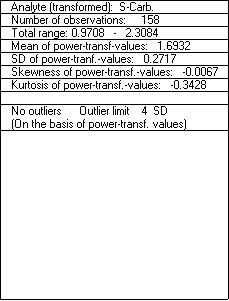CBstat: Reference Interval Estimation
The program estimates 2.5- and 97.5-percentiles with respective 90%-confidence intervals, either nonparametrically or parametrically on original or transformed values (1-3).
Nonparametric: Simple (acc. to ref. 2 or recommended procedures by IFCC or NCCLS) or bootstrap-based (2).
Parametric:
The available transformations are:
log-transformation
power-transformation (Box & Cox)
Exponential-transformation (Manly)
Two-stage power-modulus transformation
Two-stage exponential-modulus transformation
The program evaluates normality of data distributions by the Anderson-Darling test (3).
In the cases involving estimation of one or two transformation parameters, P-values provided by normality tests on transformed data are inflated (3-4). Additionally, confidence intervals are ordinarily underestimated in the latter situation. CBstat carries out appropriate adjustments (3).
Below, the Results page is shown for the demo data example enclosed with the program. The situation corresponds to a power transformation to normality. The program also displays the cumulative distribution of transformed values in relation to the cumulative gaussian function (not shown here).
Results Reference Distribution




![]()
1. IFCC, Expert Panel on Theory of Reference Values. J Clin Chem Clin Biochem 1987: 25: 645-656.
2. Linnet K. Nonparametric estimation of reference intervals by simple and bootstrap-based procedures. Clin Chem 2000; 46: 867-9.
3. Linnet K. Two-stage transformation systems for normalization of reference distributions evaluated. Clin Chem 1987; 33: 381-386.
4. Linnet K. Testing normality of transformed data. Appl Statist 1988; 37: 180-186.